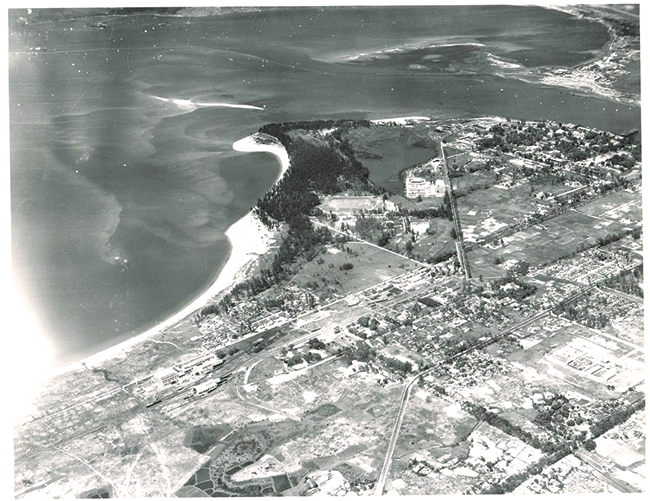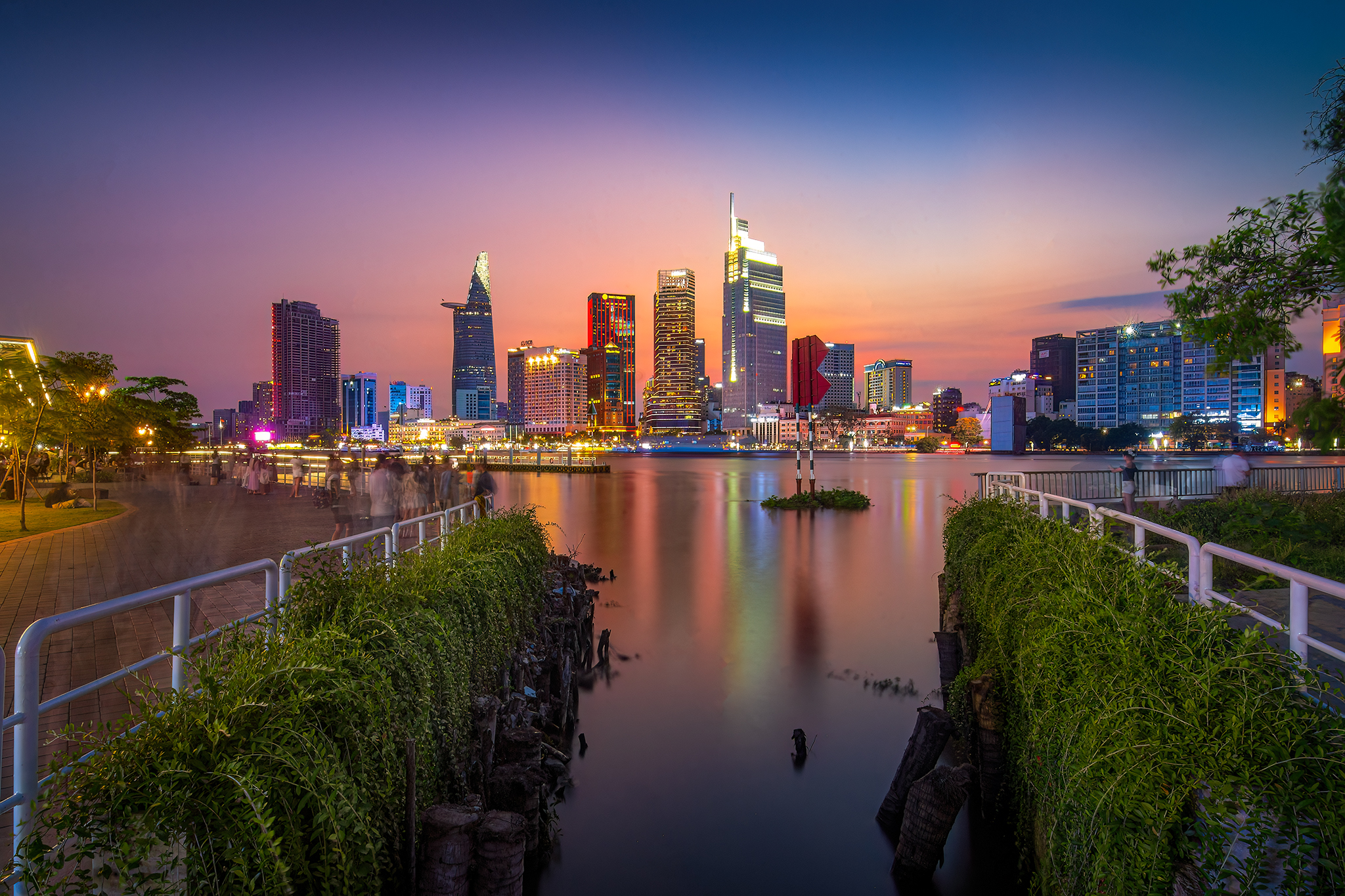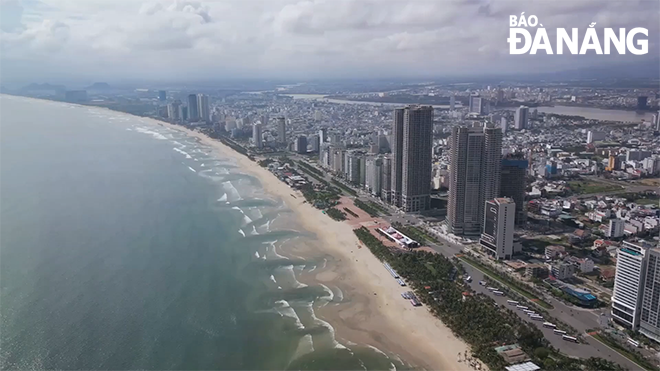Stature of Da Nang trade port from past to future
Since the 19th century, the Da Nang trading port has played an important role and position in regional and international trade. Currently, the Da Nang port system is one of the largest and most important ones in the region and it will continue to make development strides á as the Lien Chieu port will take its shape, in addition to current Tien Sa seaport.
 |
| The image of the current Da Nang port. Photo: N.XUAN TU |
“The deepest and most beautiful port”
Under the French colonial period, the Da Nang port played the role of the commercial centre of Trung Ky (the name given by Vietnamese King Minh Mang to the middle part of Viet Nam since 1834).
The first advantage is about the port's geostrategic location. After the trading ports of Hoi An, Thanh Ha and Nuoc Man lost their positions, the Nguyen Dynasty chose Da Nang as the only and official trading gateway of Hue which was Viet Nam's capital during the Nguyen Dynasty from 1802 to 1945.
Along with the landmark changes of the Nguyen Dynasty, the French colonialists in the process of scouting in the Far East also appreciated the Da Nang port.
According to Henri Imbert, the Da Nang port was one of the largest and most solid ports found in the area. The port has a deep water level, easy to navigate. In terms of security, John Barrow said that there are few ports in the West that can match it and there is certainly no port that surpasses it.
From an economic point of view, the Chamber of Commerce and Agriculture, at that time, affirmed that Da Nang port was the most beautiful port in the whole of Indochina. This port brought convenience to the trade route, save time, fuel expensive and ultimately economic benefits for ships. In addition to the function of anchorage for ships and boats, the Da Nang port also had a key position on the maritime route connecting the Indian Ocean to the Pacific Ocean.
In 1888, the planning, reclamation of sand dunes, development of wharfs, moorings, lights, warehouses, yards at the Da Nang port were quickly implemented by the French colonial government.
In the early 20th century, the investment process was expanded, attracting a large number of merchants from other foreign countries to do business. As noted by Louis Henrique in 1890, Da Nang was built on the left bank of the Han River with a length of more than two kilometers. There, it was easy to see commercial establishments and military and civilian bases, telegraph and customs facilities.
In 1930, in a report on the results of investigating the possibilities and prospects of the commercial ports in the central region, Nha Cong Chinh affirmed, Da Nang was the most important commercial centre in Trung Ky. The Da Nang port secured a special position in Indochina and was second only to Sai Gon Sai Gon (the former name of Ho Chi Minh City) in the south and Hai Phong City in the north.
In terms of commercial capacity, Da Nang port always led the Central region in terms of ship and boat traffic and volume of import and export goods. With regard to ships, according to initial statistics, the volume of ships and boats participating in commercial trade through the Da Nang port always accounted for a larger number than Vinh - Ben Thuy and Quy Nhon ports.
In the 1919 - 1944 period, the Da Nang port received 142,627 ships and boats engaged in commercial trade, while the Quy Nhon port handled 66,951 and Vinh - Ben Thuy with 17,954.
The important position of the Da Nang port in the Central region was also reflected in its ability to participate in international trade. In the 1929 - 1923 period, the Da Nang port had 2,582 steamships participating in international trade, whilst the Quy Nhon port had only 1,537 and the number of international trading ships arrived in the Vinh - Ben Thuy port was very small.
In the 1934 - 1938 period, the number of international trading ships anchored at the Da Nang port increased to 2,955 units, Quy Nhon 1,455 units and Vinh - Ben Thuy 1,690 units. If comparing more closely in terms of tonnage, the number of steamships with large tonnage docked at the Da Nang port was higher than those recorded at the Vinh - Ben Thuy or Quy Nhon ports.
As for the handling goods, the volume of import and export goods handled through the Da Nang port was also superior to that of ports in the whole Trung Ky.
Specifically, in the 1919 - 1944 period, the Da Nang port handled 2,446,283 tonnes, the Quy Nhon port 867,682 tonnes, Vinh - Ben Thuy port 1,371,477 tonnes.
In terms of percentage, the volume of import and export goods of Quy Nhon and Vinh - Ben Thuy presented only 35.5% and 56% of that of Da Nang, respectively.
To connect with other major trade centres worldwide, the French colonial government chose Da Nang as the main axis for the Central region, building an international trade network.
Therefore, the largest French water transport companies in Indochina all set up their branches here, establishing maritime routes. For example, Messageries Maritimes company established two transport routes from France to Trung Ky. One ran from Marseille to Port-Said, Djibouti, Colombo, Pondicherry, Madras, Singapore, Sai Gon and Da Nang. The other traveled from Dunkirk to Antwerp, Le Havre, La Pallice, Algiers, Port-Said, Djibouti, Singapore, Sai Gon and Da Nang. In addition, this company also established the Da Nang - Guangdong, Sai Gon - Quy Nhon - Da Nang - Hai Phong routes.
In a similar vein, the Chargeurs Réunis company also has two major transport routes connecting with Trung Ky through Da Nang port. One departed from Bordeaux of France to Marseille, Port Said, Djibouti, Colombo, Singapore, Sai Gon and Da Nang. The other started from Antwerp in Belgium via Dunkirk, Le Havre, Marseille, Port-Said, Djibouti, Colombo, Singapore, Sai Gon and Da Nang.
 |
| A view of the former Da Nang Port. |
Besides, the Da Nang port served as the main source of import and export coordination centre in Trung Ky. Most agricultural, forestry and fishery products in the Central Highlands and Central Highlands regions were exported through the Da Nang port. For example, there were tobacco, pepper from Quang Tri and Hue provinces; coal, tea, cinnamon, corn, peanuts from Quang Nam Province; silk, cotton, areca, coconut, cattle, poultry from Quang Ngai, Binh Dinh and Khanh Hoa provinces; coffee, medicinal herbs, wood, leather and animal horn bones from the Central Highlands.
Also through the Da Nang port, Trung Ky's trading partners constantly expanded their operation. In addition to such traditional partners as China, Singapore, Japan, they has expanded trade with many countries in Europe, Americas and Africa.
Imports played a central role on the world's trade route, so most of the goods were gathered at the Da Nang port before being distributed to Trung Ky. Among the items were petroleum, rubber, railway materials from Americas; machinery, components and equipment from the UK; flour, cereals, canned food from Italy and the Netherlands; beer, metal, auto parts from Germany; incense, incense, ceramics, civil paper, votive goods from China and Hong Kong (China).
Prominent central role
The importance of the Da Nang port is also reflected in the event of the entire infrastructure system and the authorities. Da Nang was the first administrative unit in Central Viet Nam to be approved to develop itself into a city, the only second-class city in the region and the starting point for important traffic projects. The system of railways, stations and trains of Da Nang was the second one in Trung Ky, after the Ha Noi - Vinh route.
By the end of the 1930s, when France established an agency to control import and export goods based on the main production areas in Indochina, the role of the Da Nang port became even more prominent. The Sai Gon port controlled cargo in Cochinchina, Cambodia and southern Lao region whilst the Da Nang port controlled both Trung Ky and central Lao region.
The next mission of the Da Nang port was to introduce and affirm the brand name of many types of goods in Trung Ky. During the French colonial period, a large number of goods were exported to other countries though the Da Nang port, contributing to shaping the brand name for Trung Ky. Thanks to this, Westerners were introduced to the taste of Nam O and Phan Thiet fish sauce, the stone processing industry in the Marble Mountains site, Quang Nam tea, Hoa Vang red corn, Cam Le tobacco, Nong Son coal and other signature products.
 |
| The map of Da Nang port development project developed by the French colonial government. |
Heading towards the future
It can be seen that, through the development process, the position of Da Nang has changed markedly. Not only has this central coastal Vietnamese city affirmed its position as a major commercial centre and seaport in the central region but it also served as a model of the coastal urban landscape of Trung Ky.
Up to now, the Da Nang port constantly developed and affirmed its role and position in freight transport and tourism in the central region, on the East-West Economic Corridor, and international scale at large.
Under Resolution 43-NQ/TW adopted by the Politburo on the construction and development of Da Nang by 2030, with a vision towards 2045, focus is on building Da Nang into an international port city with the position as the nucleus of the urban chain and the growth pole of the key economic region of the Central Viet Nam and Central Highlands regions.
Also under Resolution, Da Nang will develop into a marine economic centre, forming a supply chain of logistics services in the central region with the central role of Da Nang, accelerating investment in construction of the Lien Chieu seaport and expanding the Tien Sa port.
In line with the adjustments to the general planning of Da Nang to 2030, with a vision to 2045, approved by the Prime Minister in 2021, Da Nang will become a key logistics service centre of the central key economic region, an important traffic hub of the country, the East-West Economic Corridor’s main gate to the East Sea.
Outstandingly, at the end of December 2022, work commenced on the Lien Chieu port project in the excitement of the Da Nang authorities, people and business community. Constructing the Lien Chieu port, along with gradually transforming the function of the existing Tien Sa port into a tourism one, helps develop Da Nang into an international gateway seaport in the central coastal region and Central Highlands, connecting with regional, inter-regional and international parts.
Reporting by Ph.D DUONG THANH MUNG - Translating by A.THU








